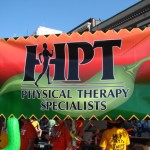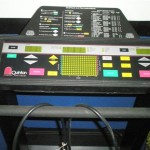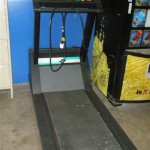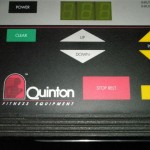HPT will be closed Monday, December 26th for Christmas and Monday, January 2nd for New Years Day. Make sure your appointsments for those weeks are scheduled on a Tuesday through Friday. If you have any questions, please contact our front desk at 304-525-4445.
HPT Coat Drive
HPT will be having a coat drive Thursday, December 1st to Wednesday, December 21st. All coat donations will be taken to the Huntington City Mission on Thursday, December 22, 2010. There is a collection box in the HPT lobby to place your coats.
We are taking coats for children and adults, new and gentle used. Please make sure all coats are washed before bringing to the office.
If you have any questions, call 304-525-4445 and speak to Kevin Burton or Angie Slomke. The drop off address is 2240 5th Avenue.
A New Breed of Knee Injury in Young Athletes
Sometimes physicians will notice a medical trend well before science confirms its existence. That has been the case with injuries to the anterior cruciate ligament, the main ligament that stabilizes the knee joint, in young athletes. “Doctors who treat kids have all been saying over and over that the numbers of A.C.L. tears are going up dramatically,” says Dr. J. Todd Lawrence, an orthopedic surgeon and pediatric sports medicine specialist at the Children’s Hospital of Philadelphia. But surprisingly little firm data has confirmed that hunch.
So, for a study presented this month at the annual conference of the American Academy of Pediatrics in Boston, Dr. Lawrence and his colleagues parsed emergency room records of pre-adolescent youngsters treated at Children’s Hospital, looking for A.C.L. tears, as well as tears of the meniscus, the small pillows of cartilage that help to cushion the knee bones.
They also checked for fractures of the tibial spine, a fingerling spit of bone that extends from the tibia, or shinbone, to which the A.C.L. attaches. In prepubescent children whose skeletons are still growing, the slender tibial spine can be weaker than the tissues of the A.C.L. and break under the pressures of hard twisting or planting of the knee, even as the A.C.L. remains intact. “There was a time when the tibial spine fracture was the knee injury of childhood,” Dr. Lawrence says. “Twenty years ago, medical textbooks usually included a statement saying that kids did not tear their A.C.L., that they fractured the tibial spine instead.”
But when the researchers examined the pediatric hospital records, from 1999 through early this year, they found only 155 tibial spine fractures, while there were 914 confirmed A.C.L. tears and 996 meniscus tears. More important, while the incidence of tibial spine fractures increased at a rate of about 1 percent per year during that period, the incidence of A.C.L. tears increased by more than 11 percent per year. The difference almost certainly was not a result of better equipment leading to better diagnoses of A.C.L. tears, Dr. Lawrence says. “Even in 1999, M.R.I. technology was quite good,” so it was possible for physicians to differentiate between the injuries.
Which means that increasingly large numbers of young athletes, both boys and girls, are now suffering an injury to which doctors once thought they were almost immune.
Most of the A.C.L. tears that were treated at Children’s Hospital and picked up by this study, Dr. Lawrence points out, also involved a simultaneous meniscus tear, an indication of just how much wrenching and grinding the knee had undergone. Injury patterns have changed, he continues, because childhood sports have changed. “There’s a developmental soccer team here” in Philadelphia, he says, “for U-6 players,” meaning a competitive, select team for 4- and 5-year-olds. “When I heard that, I said, are you kidding me?”
The long-term effects of sports-related A.C.L. and meniscus tears in youngsters remain largely unknown, in part because such injuries were so rare decades ago. But there are indications that the consequences could be calamitous.
Recent studies of adult Swedish soccer players who tore an A.C.L. found that, within 12 to 14 years after the injury, 51 percent of the female players and 41 percent of the men had developed severe arthritis in the injured knee. The same time frame could have an injured 10-year-old dealing with a severely arthritic knee before he or she is 25. Meanwhile, many athletes who return to sports after an A.C.L. tear report that they don’t play as well, according to a new study of 500 Australian athletes, and a third of the athletes in that study did not return to any activity afterward.
“It’s definitely not a minor injury,” Dr. Lawrence says, “and it’s not something you want to see in a child.”
Whether anything can be done to lessen the toll on young knees, though, is uncertain, he and other researchers say. Knee injury prevention programs, including those that teach balance and proper landing techniques, have shown some utility in reducing the incidence of A.C.L. tears, especially in girls. But the programs are relatively new and have not been universally successful, in part, perhaps, because they can make some young athletes overly self-conscious, as an interesting review article published earlier this year suggests. In teaching children to think overtly about how to plant a leg or bend a knee while maintaining balance, some youngsters may become less fluid in their movement, more ungainly — and potentially ripe for injury, the review’s authors speculate.
A better solution would probably be to stop assuming that children can train like miniature Ronaldos or Kobe Bryants. “A lot of what we see in our injury data is almost certainly due to a statistical measure called exposure hours,” Dr. Lawrence says. “The more you do a risky activity at a high level, the more likely you are to get hurt.” His advice? “Encourage kids to play multiple sports and not to do any one sport year-round, and especially not when they’re 5 or 6, or even 9 or 10. They’re kids. Let them play and have fun, like kids.”
Physical Therapy and Parkinson’s disease
By: Aleacha Wallington, PT
Parkinson’s disease (PD) is a chronic progressive disease that affects the motor component of the central nervous system. In simpler terms this means that the brain does not send correct signals to muscles for accurate body movements. It is a movement disorder characterized by rigidity, tremor, and slowness of movement. Other symptoms may include: shuffling while walking, lack of facial expression, small handwriting, excessive saliva, difficulty swallowing, difficulty speaking, frequent falls, and freezing. The cause is unknown but there are possible links to genetic mutations and environmental exposure to toxins or viruses. Recent studies have suggested that treatment should not only include medication but also exercise. The medication for PD helps treat the symptoms by increasing the brain’s supply of dopamine. Dopamine is the chemical or messenger in the brain that is decreased with PD. A recent study by Dr. J Eric Ashlskog suggested that an intense exercise program can have positive modifying effects slowing the progression of the disease. Physical therapists are uniquely qualified to design an exercise program for individuals with PD whether a person is newly diagnosed or has been diagnosed for years.
Physical therapists can improve an individual’s confidence and function while promoting safety with daily functional activities. Ideally, physical therapy should begin as soon as an individual is diagnosed, but gains can also be made in the later years of PD progression. The early stages are the best time to begin a program that is specially tailored to improve or slow down the progression of movement symptoms. The goal of therapy is to teach an exercise program that can be performed on a daily basis and become a lifelong routine.
A good exercise program for an individual with PD will be challenging and address functional limitations. These functional limitations can be as simple as rolling over in bed or getting up out of chair and as challenging as playing golf or performing work activities. Exercises should focus on several different factors including improving spinal mobility, balance, posture, strength, and speed of movements such as walking. Physical therapy will also include education and evaluation for assistive devices and home modifications to prevent falls. For an exercise program to have the most benefit it is important to think of it as a daily medication. We do not want to miss a dose of medication because we know it will have negative effects. Missing a dose of exercise is similar in that we will not see maximum benefits (and may not be able to slow the progression of PD) if it is not performed on a daily basis.
Rehabilitation of individuals with PD is different than treatment of patients with other neurological diseases and it is important for these patients’ to see a therapist familiar with specialized PD treatment.
Aleacha Wallington, DPT is a licensed physical therapist at HPT Physical Therapy Specialists in Huntington, WV. She specializes in treatment of patients with Parkinson’s disease and other neurological conditions. She can be reached at 304-525-4445 or awallington@hptservices.com.
Shoulder pain causes can be prevented or minimized by: John Oxley, PT
Surprisingly, between 18 and 31 percent of the adult population experience shoulder pain during any 30-day period. There are many causes of shoulder pain including rotator cuff tendonitis or tears, adhesive capsulitis, shoulder instability and osteoarthritis. If we can identify risk factors for these conditions, we can prevent or at the very least minimize the problem.
Some lifestyle risk factors for shoulder pain and more specifically rotator cuff issues include obesity, tobacco use, and type 1 diabetes mellitus. These risk factors are believed to contribute to rotator cuff tears because of the restriction of blood flow related to nicotine and diabetes. The rotator cuff tendon suffers from limited blood flow anyway making it more susceptible than other tendons to chronic injury and tearing. Other risk factors that make people susceptible to shoulder injury include working with arms above shoulder level; hand-arm vibration; repetitive movements; pushing and pulling; and carrying loads supported by the shoulder.
A proactive approach to shoulder health includes brief daily stretching, posture improvement, intermittent rest breaks from overhead activity, and early identification of shoulder dysfunction. Early identification is extremely important because shoulder problems can get significantly worse if ignored and depending on the condition can be irreparable if unchecked. Conversely, acute shoulder pain responds well to intervention and early treatment can decrease productivity loss dramatically.
There are some seasonal activities on the horizon that are a common complaint and source of pain for my patient population: Raking leaves, shoveling snow, putting up Christmas decorations/lights, and weight training associated with early new years resolutions are just a few. You cannot avoid these activities, but you can be smart while undertaking these “must dos” by doing the following:
Take frequent rest breaks to change body position.
Don’t try to finish it all at once.
Use a ladder for reaching places overhead. Be careful when using a ladder, because the injuries associated with falling off a ladder can be far worse than a little shoulder pain.
Early treatment is important when it comes to treating shoulder problems efficiently and effectively. This is especially true when it comes to suspected rotator cuff tears because ignoring the problem can have catastrophic repercussions in some instances. Adhesive capsulitis is another condition that the research has recently supported treating early to prevent further freezing or loss of motion.
If you simply know that your shoulder hurts and don’t really know why then you should have a physician or physical therapist evaluate you. Possible treatments include steroid injections, surgery, oral medications or physical therapy to address your pain or limitations in function. In conclusion, be aware of shoulder position during seasonal or work activities, a healthy lifestyle can positively effect your joint health, and don’t wait to address your problem because the earlier it is addressed typically the more successful we are with treatment.
If you have any questions, email John at joxley@hptservices.com.
HPT Wins 3rd place at ChiliFest 2011
September 17, 2011 was a fun day for the HPT staff that worked the ChiliFest. This was our first year at the ChiliFest and we all had a blast spending time together and serving chili to the Tri-State. We won 3rd place in Best Booth and Showmanship and came in 7th place for People’s Choice. Thank you to everyone who visited our booth. Come back and visit our booth next year.
HPT Banner for ChiliFest
3rd Place Prize for Best Booth and Showmanship
HPT Crew at the ChiliFest
Chili Fest 2011
The 28th WV State Chili Championship is Saturday, September 17th on 3rd Avenue in Huntington. All proceeds go to the Ronald McDonald House Charities of the Tri-State. There will be judging of Red Chili, Chili Verde and Salsa. HPT will have a booth and dishing up some great tasting chili.
Mark your calendars to come to Huntington Chili Fest on Saturday, September 17th to support a great cause and taste chili, salsa and chili verde.
Treadmill For Sale
HPT has a Quinton treadmill for sale. The treadmill is in good condition and takes a 220 volt outlet. If you want to look at it, call 304-525-4445 to talk to Kevin.
Free Video Gait Analysis by a Licensed Physical Therapist
Video Gait Analysis
Have you ever walked into a shoe store and wondered which type of shoe may ease your foot, leg, hip or back pain? Or been running a race and wondered if different gait mechanics would allow you to run your personal best time? Then come in and check out our new video gait analysis program!
Video gait analysis is a comprehensive way to study your body mechanics during running and walking. It allows us to analyze each individual component of the gait cycle in a frame-by-frame fashion. We obtain video from four different views in order to determine ways in which your gait deviates from normative values and how one side of your body differs from the other. Once deviations are identified, we can effectively determine the source of your pain and/or recommend ways to make your stride more efficient!
People of all ages and abilities can benefit from this new service as it can take as little as 5-10 minutes. Time spent walking and/or running on the treadmill can be broken up into intervals if necessary to meet the needs of each individual patient. The more advanced athlete may choose to be analyzed in different types of footwear in order to determine how to create their most efficient foot placement and stride. This is a great tool for those exercisers that have been suffering from a chronic injury for months or years and don’t understand the source of the pain or how to rid themselves of it. Whatever your needs, let us help ease your pain and maximize your full locomotive potential with the region’s only video gait analysis program at Huntington Physical Therapy!
During the month of August, Kelly Akers, DPT will be performing video gait analysis targeting athletes who suffer from running related injuries. Space is limited, so call today at 304-525-4445 and make your appointment with Kelly Akers, DPT for your free video gait analysis.
Preventing ACL injury is not impossible
June 09, 2011
The Herald-Dispatch
By: John Oxley, DPT
Anterior Cruciate Ligament (ACL) tears are devastating injuries in young athletes, especially in female athletes. Young females are four to six times more likely to tear their ACL than men. The reported incidence of ACL injury is as high as 1.6 per 1,000 player-hours for elite female athletes playing soccer and there are about 38,000 cases in the United States each year. Therefore, prevention is an important component in reducing the effect on young athletes and their families.
Many theories have been proposed to explain the higher incidence of ACL injury in females. The three most well accepted hypotheses include anatomical, hormonal, and neuromuscular differences as compared to male counterparts. The research has focused on neuromuscular control which can be addressed through training.
The majority of ACL injuries, approximately 70 percent, occur with noncontact injuries and typically during deceleration, change of direction or landing after jumping. We obviously cannot prevent contact ACL injuries, but research has shown that incorporating plyometric, balance and strengthening exercises into a program can reduce noncontact ACL injuries.
Specific time and frequency prescriptions for these exercise programs have not been agreed upon in the research, but one thing is certain: there is a measurable decrease in incidence of ACL injury when players or teams are participating in these programs. Many different programs have been designed that vary with respect to intensity, duration and frequency of exercise and you must consult your local physical therapist or orthopedic surgeon to see what program they prefer.
Typically, young athletes and parents are reluctant to participate in preventative exercise due to cost or time investment but if the program can also be used to enhance performance they might be more amenable to the idea. Each program must contain plyometrics, balance, and strengthening components to be successful. Anecdotally, I would say each program needs to focus on jumping/landing training as well. This can be a tool for the future to prevent these catastrophic injuries to our young athletes.
Everyone has heard the old saying “an ounce of prevention is worth a pound of cure” and that saying by Benjamin Franklin is definitely appropriate for this topic. Too often, orthopedic surgeons are having to reconstruct young damaged knees that will inevitably have further problems in the future. We certainly can not prevent all of these injuries but with performance training directed by a qualified professional the research shows that we can decrease the frequency of this significant injury in our young athletes.







